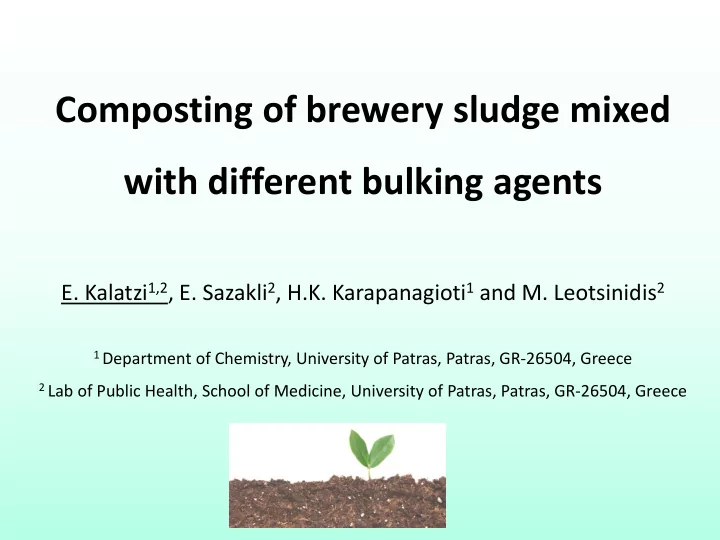

Composting of brewery sludge mixed with different bulking agents E. Kalatzi 1,2 , E. Sazakli 2 , H.K. Karapanagioti 1 and M. Leotsinidis 2 1 Department of Chemistry, University of Patras, Patras, GR-26504, Greece 2 Lab of Public Health, School of Medicine, University of Patras, Patras, GR-26504, Greece
Introduction • Re-use of waste is the key for sustainable development • Sludge is NOT a waste • It is rather a source of nutrients • Composting: one of the most promising technologies allowing recycling of biosolids
Why brewery sludge? Solid-waste disposal problem and management European Directives 2006/799/EC and 2007/799/EC Composting requires Biosolids Bulking agents
Purpose Composting of brewery sludge with three different bulking agents
Parameters Temperature Moisture pH Conductivity Volatile solids Organic Nitrogen Carbon to nitrogen ratio Total phosphorus Metals Microbiological quality
Composting Stages
Composting set-up • 3 co-composting materials – lignite – sawdust – dried shredded grass • Temperature measurement three times per week • Agitation once per week • Sampling once per week before agitation
Location … Greenhouse of University of Patras
Sludge + sawdust Sludge + lignite Sludge + shredded grass
Results
Temperature
Moisture
pH
Electrical conductivity Final Values Composts (mS/cm) Grass mixture 3.3 Lignite mixture 1.8 Sawdust mixture 1.1
Volatile Solids
Organic nitrogen
C/N ratio C/N ratio → stable at 10:1 (during the whole process) According to bibliography initial optimum ratio 30:1
Total Phosphorus
Metals Final compost (mg kg -1 DM) Legislative guidelines a (mg kg -1 DM) Elements Lignite Sawdust Dried grass Cd 0.14 <0.02 <0.02 1 Pb 7.5 8.9 7.6 100 Cr 110 56.3 52.7 100 Ni 377 60.3 32.5 50 As 43.3 3.1 3.2 10 Cu 56.2 54.0 74.5 100 Zn 93.5 35.6 126 300 Co 23.6 14.3 11.2 - Mn 672 591 479 - Fe 23800 19000 14800 - Na 2980 3520 6710 - K 6440 7040 8790 - Ca 11600 17900 19800 - a : Commission Decisions 2006/799/EC and C(2006) 6962 (ECO Label to soil improvers and growing media, Mg 11800 6630 5600 - respectively
Microbiological quality Pathogen Lignite Sawdust Dried grass 2006/799/EC E. coli (CFU g -1 dw) 483 1291 68 1000 Salmonella absence absence absence absence (CFU per 25 g dw) Enterococci 57 459 2411 - (CFU g -1 dw) Clostridia (CFU g -1 dw) 352 0 221 -
Conclusions Mixtures with dried grass and sawdust yielded composts of acceptable quality for specific uses, such as soil remediation Lignite was considered as an inappropriate bulking agent due to high metals concentrations measured in the final product The most promising, suitable and low cost bulking agent was the dried shredded grass Co-composting of brewery sludge with lower than optimum initial C/N ratios is feasible and allows the minimization of the required amount of bulking agent, if composting aims at solving the sludge disposal problem Final products were categorized as Class B. Characterization of Class A will be feasible, by constructing bigger piles and thus, achieving higher temperatures during composting
Thank you!!!
Recommend
More recommend